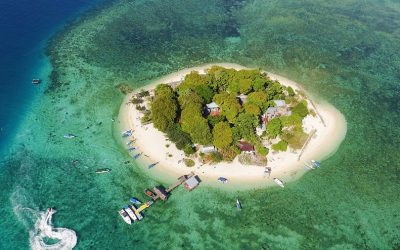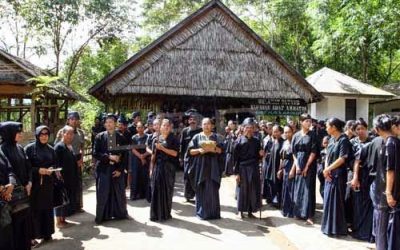Home / Batik Regions – Central Indonesia – Sulawesi Island – South Sulawesi / Tana Toraja National Heritage Site
Cultural Destination
Embrace the spirit of the place!
Tana Toraja National Heritage Site
Toraja Traditional Settlements in Kete Kesu Village, Tana Toraja Regency (Photo: 22Kartika.Wikipedia)
Limbong natural lake in Rantepao, North Toraja (Photo: @Diansix234)
Tana Toraja National Heritage Site
One cannot miss the wonder of Kete Kesu Village in Tana Toraja. South Sulawesi is known for the homeland of Toraja ethnic and its wonderful legacy. In this place, you will discover Toraja traditional settlements called Tongkonan. Tongkonan is a wooden stage house, decorated with original Toraja carving motifs. One of the famous wood carving motif is Pa’tedong motif that represents the face of a buffalo. The Pa’tedong motif is a symbol of hopes, abundance, and prosperity of the Toraja people.
Situated one hour driving from Kete Kesu Village, Limbong lake is another beautiful characteristic of this place. If you are seeking for relaxation, tranquillity and stunning view with Toraja cultural landscape, you should definitely come and enjoy the beauty of this place!
Cultural Tourism Destination
Tana Toraja National Heritage Site
Tourist Attractions in South Sulawesi
Samalona Beach
If you are longing for a small getaway on an island with blue sea and white sand, this island
Ammatoa Indigenous Village
Kajang tribe of Ammatoa Village is known for their typical traditional ceremony that is practiced to reveal
Bantimurung National Park
Have you ever thought if the Kingdom of Butterflies really exists in the world?
South Sulawesi
Batik Motifs
Paqbarre Allo
The word “Barre” means round and “Allo” means the sunlight. This motif is interpreted as
Tongkonan
Toraja’s traditional house is called Tongkonan. Tongkonan is a place for
La Galigo
La Galigo is a literary work of the Buginese Epic that has 300 thousand epic lines. It is considered even
Lontara
The Lontara script itself is a typical ancient script of Bugis and Makassar communities. History records that
Discover
Indonesian
Batik
Motifs
Sido Mulyo
Sidomulyo is one of the classical motifs, which is specifically used for the bride’s costume in
Salakanagara
Salakanagara batik motif illustrates the first kingdom in the Betawi land
Awan Berarak
Awan Berarak is a combination of Dayak motifs and Malay patterns. The word ‘Awan Berarak’ means the
Manguni Minahasa
Manguni is identified as the symbol of the Minahasa people. Manguni is known as a
Keluak Daun Pakis
The word “Keluak” is a Minang language which means twisted or tangled. The Motif of
Lok Baintan Floating Market
As you can imagine, the most authentic thing is that you can buy things and even
Tongkonan
Toraja’s traditional house is called Tongkonan. Tongkonan is a place for
Mahkota Siger
Siger is the crown of a noblewoman in ancient time. It is a symbol of femininity, strength, and
Kain Cual
Cual textile tradition has existed since the 17th century. The word “Cual” refers to
Raja Ampat
Raja Ampat motif represents the marine life at Raja Ampat archipelago in
Sandeq
Sandeq Boat is a symbol of the maritime importance of the West Sulawesi region. The greatness of
Pinawetengan
The Pinawetengan Batik pattern was taken from a prehistoric inscription in
Paqbarre Allo
The word “Barre” means round and “Allo” means the sunlight. This motif is interpreted as
Pati-Pati Pinehiku
It symbolizes the hierarchy in society and the social status of the Mekongga
Kasih Tak Sampai
‘Kasih Tak Sampai’ is an idiom in the Indonesian language which refers to
Sekar Jati
Sekar means flower and Jati refers to teak trees that symbolizes a strong mental character that
Wakatobi
It symbolizes the coastal beauty of the Wakatobi island and the symbol of Patra symbolizes
Gedhog Kembang Waluh
a combination of Javanese cultural motif of the Majapahit kingdom (XII-XIV century) with
Gurdo Solo
Gurdo or garuda bird is the mount of the Indian god Vishnu. As the Sun Bird,
Gigi Haruan Lidi
The Gigi Haruan Lidi motif is taken from the name of the cork fish and is a symbol of
Sero Tangga
The Sero Tangga illustrates an endearing feeling and sacrifices of a person to fulfil
Gorga Simeol-Meol
The Gorga Simeol-meol is a pattern of plant tendrils. it is regarded as a symbol of longevity and
Tikar Natuna
The Tikar Natuna motif is adapted from the traditional making of pandanus mats in
Tengkawang Ampiek
With its many advantages, the Dayaks use this leaf in ritual ceremonies. This plant is a symbol of
Besurek Rafflesia
The term “Basurek” refers to a textile that contains letters or inscriptions
Daun Sirih
This motif illustrates betel leaves that are used by Lombok communities as traditional
Hiu Taliyasan
Indonesia is also home to the world’s largest fish, the whale shark (Rhincodon typus). Hiu Taliyasan refers to
Ake Patra
Ake is related to the divinity and the composition of the universe. It is a symbol of
Insang Ikan
Insang refers to the gills of the fish. This is a typical pattern of Malay ethnic who inhabits
Parang Rusak
Another meaning behind this motif is an unconquerable spirit, symbolized by
Prada Papua
The word “Prada” in the Javanese-Indonesian dialect means a batik textile that
Honai
The Honai is inspired by the traditional house of the Papuan community living in
Gamolan
This motif illustrates Gamolan, a bamboo musical instrument of Lampung that is
Wirasat
Wirasat or divine inspiration is a gift from God. This inspiration is symbolized by
Lipaq Sabe
Lipaq Saqbe contains a simple geometric classical motif with various flower decorations. This textile is
Pattimura
Pattimura is the name of an Indonesian hero who fought against colonialism in
Dayak Taghol
Dayak Taghol has a distinctive style of four curved lines and small dots. This motif represents
Gumin Tambun
Based on Hindu mythology, this motif symbolizes lucks, abundant wealth, and
Tabir Tanjung
Tanjung flower is a type of Cherry tree flower, which is commonly found in
Besurek Rembulan
This batik illustrates praise for God who created the wonderful universe
Tenun Bima
The motifs are adopted from Bima woven textile. This pattern has received a great
Tifa Totobuang
The batik motifs illustrate Maluku’s traditional music instrument called
Enggang Dayak
Local people beliefs that hornbills are an incarnation of the Commander of the Birds. It has supernatural
Pohon Hayat (Tree of Life)
The Batik motifs in Lampung are dominated by the acculturation of Buddhist and
Buketan Bali
The Balinese bouquet (Buketan Bali) is a floral arrangement and the name is
Gonggong Siput
Gonggong (Strombus Turturella) is one type of sea snail found around
Bomba Mawar
This motif means sacred love for family, kingdom, and God; It also illustrates
Desa Na Tolu
The Desa Na Tolu characteristic pattern symbolizes the Batak philosophy of existence and
Sekomandi
Its philosophical meaning is the eternal union which refers to a saying “until death do us part”
La Galigo
La Galigo is a literary work of the Buginese Epic that has 300 thousand epic lines. It is considered even
Daun Lada Hitam
The black pepper motif represents the main commodity of Bangka Belitung
Kuda Kupang
Horses symbolize wealth. It contains noble values of virtuous characters that bring
Taiganja
Taiganja is a precious gold pendant that shows the social status of the Kaili family. It is
Kaharingan
The Kaharingan or ‘tree of life’ based on the Dayak tribes’ belief system. This tree symbolizes
Bultiya
The word ‘Bultiya’ is an acronym of the three major tribes in North Kalimantan, namely
Pucuk Rebung Riau
Pucuk Rebung symbolizes heart determination in achieving goals, good luck, and
Kaganga Tanah Rejang
If Batik Besurek combines Arabic calligraphy motifs, then the Kaganga batik takes
Jumputan Bintang
The word Jumputan means the tie-dye technique, while the word “Bintang” refers to
Bale Lumbu
This motif signifies the welfare of the ancient Sasak society. Bale also symbolizes the
Tubo Kelapa
Coconut tree is a symbol of a good character and strong mentality. It illustrates the more success a person, the more
Rumah Mamuju
the Batik motif illustrates the house of Mamuju King with the stairs, located on the left of the wooden stage house
Jupri Kembang Teh
Kembang Teh illustrates the tendrils of tea plants that grow in the highlands of
Tampuk Manggis Sasirangan
The motif illustrates the philosophy of the mangosteen fruit, which is
Durian Pecah
Broken Durian motifs depict the foundation of faith. The second half signifies the mastery of
Karawo Pinang
Pinang refers to the Palm areca tree. This motif is considered as the original
Bintik Tujuh
The Bintik Tujuh (Seven Dots) motif has 7 white spots and green color gradation as
Tangerang Herang
Tangerang Herang motif is a symbol of Tangerang city. The Tangerang Herang batik motif consists of
Cengkeh
The clove flower motif is the main commodity of the Tolitoli Regency. This motif represents
Kawung
The Kawung motif was created by Sultan Agung Hanyokrokusumo (1593 – 1645) as a symbolic gift for
Karawo Mahkuta
Mahkuta refers to Gorontalo’s traditional crown. It represents noble characters of
Kerawang Tegak Aceh
The Vertical Upright (Kerawang Tegak) Motif symbolizes a person who has a strong
Leuit Sijimat
This motif reflects the daily activities of the Baduy tribe in Banten. The main ornaments of batik motif consist of:
Gajah Way Kambas
The motif illustrates the Lampung’s natural reserve, the Way Kambas. it also symbolizes
Dayak Kamang
Kamang motif is generally found in the Dayak tribe shield because it is believed to





